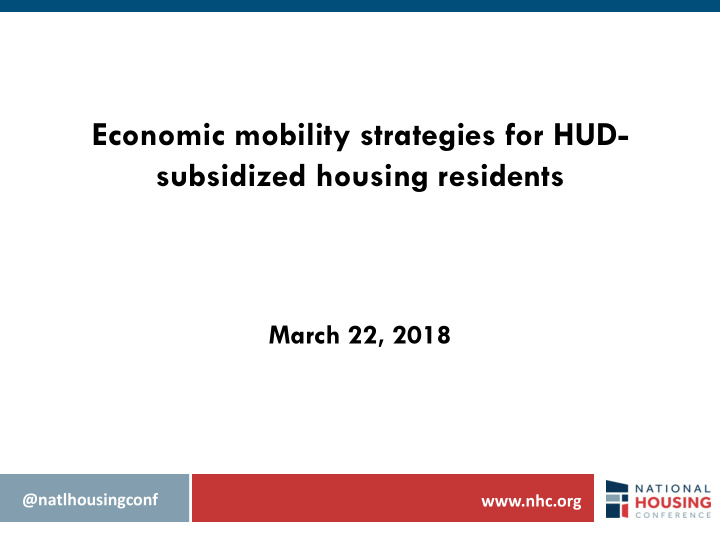



Economic mobility strategies for HUD- subsidized housing residents March 22, 2018 @natlhousingconf www.nhc.org
Panelists • Sherry Riva, Compass Working Capital • Adrianne Todman , National Association of Housing and Redevelopment Officials • Rebekah King , National Housing Conference @natlhousingconf www.nhc.org
About NHC The National Housing Conference educates decision makers and the public about housing policies and practices to move housing forward together. NHC convenes and collaborates with our diverse membership and the broader housing and community development sectors to advance our policy, research and communications initiatives to effect positive change at the federal, state and local levels. @natlhousingconf www.nhc.org
Questions & Technical Details • A link to view the presentation and download slides will be emailed to everyone who registered • Ask us questions via the Questions box in your GoToWebinar module • Use the Help menu or visit http://support.citrixonline.com/ for support @natlhousingconf www.nhc.org
Panelists • Sherry Riva, Compass Working Capital • Adrianne Todman , National Association of Housing and Redevelopment Officials • Rebekah King , National Housing Conference @natlhousingconf www.nhc.org
The Journey to a “Platform” • Public Housing – Created in the 1930s. Generally available only to working-class families. – Over the years, families who remained had lower incomes or fixed incomes. – Average living wage jobs disappeared. – Average income: $12,000/household • Section 8/Housing Choice Voucher Program – Created in the 1970s. Rental subsidies in market-rate apartments. – Subsidies can be used to pay mortgages. – Average Income: $14,454/household
Mobility Programs: Then and Now • Economic Development/Supportive Services (EDSS) • Tenant Opportunities Program • Public Housing Drug Elimination Program • HOPE VI CSSP • Tenant Opportunities Program • ROSS • Family Self-Sufficiency • CHOICE Neighborhoods • Jobs Plus
Family Self-Sufficiency • Operating for 25 years. • Of the 3,300 housing agencies, approximately 750 have received FSS coordinator funding over past five years. • Strengths: – Meeting families “where they are” – Families create their own goals – Escrow accounts!
Section 3 • Not just a requirement, but a powerful tool! – Section 3 of the Housing Act of 1968. – Public housing resident or low-income person residing in area where covered assistance is expended. – Section 3 “business concerns” • 51% or more owned by Section 3 residents • At least 30% Section 3 FT employees • More than 25% of subcontractors meet at least one of the criteria above • Private sector vendors are critical partners. – Capital Fund – Redevelopment work – Service contracts • Challenges: Resident Readiness, Licensing, Job Tenure
Moving to Work • Deploying resources for services supporting work • Incentivizing work via rent reform strategies • Abt Associates’s “Innovations in the Moving to Work Demonstration” and the Public and Affordable Housing Research Corporation's “Testing Performance Measures for the Moving to Work Program”
Innovations Across the Country • Lake County Housing Authority’s Family Literacy Night • Fort Worth Housing Authority’s financial coaching: Lending Circles • Maryland Dept of Housing/Community Development’s Open Works incubator space and programs in digital fabrication • County of San Bernardino’s partnership with local Workforce Dept. Almost 300 residents hired in under 3 years. • Freeport Housing Authority’s Teen Workforce Development Institute, which teaches soft skills to youth
Questions? @natlhousingconf www.nhc.org
Recommend
More recommend